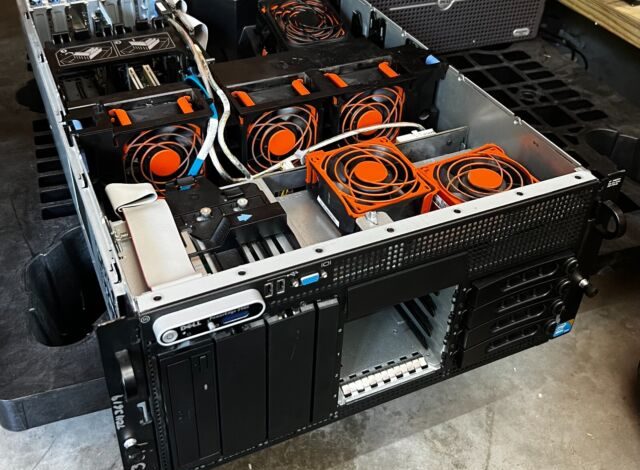Dell PowerEdge 2900 Server Best Price in UAE

What is a Dell PowerEdge 2900?
The Dell PowerEdge 2900 is a server produced by Dell Inc., which was first released in 2006. It was designed to meet the needs of small and medium-sized businesses, as well as larger organizations that required a high-performance, scalable server. The PowerEdge 2900 was available in a tower or rack-mountable form factor and featured Intel Xeon processors, up to 64GB of RAM, and support for multiple hard drives and RAID configurations. It was also equipped with various management and monitoring tools, such as Dell OpenManage and Dell Remote Access Controller, for easy administration and maintenance of the server. While it is no longer being manufactured, the Dell PowerEdge 2900 was a popular and reliable server for many years.
Read more: Get up to 25% off renting laptops near me
What does a Dell PowerEdge server do?
A Dell PowerEdge server is a high-performance computer designed to handle a variety of business-critical applications, such as database management, virtualization, cloud computing, and enterprise resource planning (ERP). Some of the key functions of a Dell PowerEdge server include:
Data storage:
Dell PowerEdge servers offer ample storage capacity to store large amounts of data. They also support multiple hard drives and RAID configurations for data redundancy and backup.
Virtualization:
With virtualization software, a Dell PowerEdge server can run multiple virtual machines, allowing businesses to save on hardware costs and increase efficiency.
Cloud computing:
Dell PowerEdge servers can be used to host cloud-based applications, enabling users to access them from anywhere with an internet connection.
High-performance computing:
Dell PowerEdge servers are optimized for high-performance computing workloads, such as scientific research, simulations, and data analytics.
Security:
Dell PowerEdge servers offer advanced security features, such as hardware-assisted encryption, secure boot, and system lockdown, to protect against cyber threats and data breaches.
Overall, Dell PowerEdge servers are powerful, reliable, and flexible machines that can be customized to meet the specific needs of any business or organization.
How long does a Dell PowerEdge server last?
The lifespan of a Dell PowerEdge server can vary depending on several factors, including usage, maintenance, and technology advancements. However, Dell PowerEdge servers are designed to be durable and reliable, and they typically have a lifespan of five to seven years or more.
Dell offers a three-year basic warranty on its servers, which can be extended up to five years or more with additional service contracts. In addition to regular maintenance and updates, replacing hardware components such as hard drives, power supplies, and fans can help extend the lifespan of the server.
However, as technology advances and new hardware and software become available, the usefulness and efficiency of a server may begin to decline. After five to seven years, it may be more cost-effective to replace the server rather than continue to invest in upgrades and maintenance.
Ultimately, the lifespan of a Dell PowerEdge server depends on a variety of factors and can vary based on the specific usage and maintenance practices of the server.
How much power does a Dell PowerEdge use?
The power usage of a Dell PowerEdge server can vary depending on the specific model, configuration, and usage patterns. However, Dell provides power consumption information for each of its PowerEdge server models in the product specifications.
As an example, the Dell PowerEdge R640 rack server, which is a newer model released in 2018, has a typical power consumption of around 700 watts. However, this can vary depending on the specific configuration of the server, such as the number of processors, memory modules, hard drives, and other peripherals.
It’s worth noting that power usage can also be influenced by the workload on the server. During periods of high usage, the server may consume more power than during periods of low usage.
Overall, the power usage of a Dell PowerEdge server can vary depending on many factors, but it is typically in the range of several hundred watts to a few kilowatts. To determine the exact power consumption of a particular server, it is best to consult the product specifications or perform power usage measurements using a power meter or monitoring software.
How many cores does Dell PowerEdge have?
The number of cores that a Dell PowerEdge server has can vary depending on the specific model and configuration. Dell offers a range of PowerEdge servers with different processor options, including Intel Xeon and AMD EPYC processors, which have varying numbers of cores.
For example, the Dell PowerEdge R740 rack server can be configured with up to two Intel Xeon Scalable processors. Each of which can have up to 28 cores, resulting in a maximum of 56 cores. Similarly, the Dell PowerEdge R7525 rack server can be configured with up to two AMD EPYC processors. Each of which can have up to 64 cores, resulting in a maximum of 128 cores.
It’s worth noting that the number of cores can have a significant impact on the performance of a server, particularly when running multi-threaded applications. However, other factors, such as memory, storage. Network bandwidth, can also influence the overall performance of a server.
To determine the exact number of cores available in a particular Dell PowerEdge server. It is best to consult the product specifications or contact Dell customer support.
What generation is my Dell PowerEdge server?
To determine the generation of your Dell PowerEdge server. You can look for the model number or service tag, which is typically located on a label on the front or back of the server. The model number or service tag will provide information about the specific model and configuration of the server. Which can be used to identify the generation.
For example, if the model number is “Dell PowerEdge R710”. The “R710” indicates that the server belongs to the 10th generation of Dell PowerEdge servers. Similarly, if the service tag starts with “9” or “10”, the server likely belongs to the 9th or 10th generation, respectively.
Dell has produced several generations of PowerEdge servers. With each generation offering improvements and advancements in performance. Power efficiency, and management features. The specific generation of your Dell PowerEdge server can provide valuable information about its capabilities and compatibility with newer hardware and software.
Benefits of Dell PowerEdge 2900
The Dell PowerEdge 2900 server is an older model, first released in 2006. Has since been superseded by newer models. However, there are still some benefits to using the Dell PowerEdge 2900 server in certain situations, including:
Cost-effective:
As an older model, the Dell PowerEdge 2900 server can often be found at lower prices than newer models. Making it a cost-effective option for small businesses or organizations with limited budgets.
Expandable:
The Dell PowerEdge 2900 server supports up to eight hard drives and up to 64GB of RAM. Providing ample storage and memory capacity for many applications. It also has multiple PCI Express slots for additional expansion.
Robust:
The Dell PowerEdge 2900 server is a robust and reliable machine. Designed for continuous operation in data centers and other demanding environments. It features redundant power supplies and cooling fans for added reliability.
Remote management:
The Dell PowerEdge 2900 server comes with Dell’s OpenManage software. Which allows for remote monitoring and management of the server, making it easy to troubleshoot and maintain.
Compatibility:
The Dell PowerEdge 2900 server is compatible with a wide range of operating systems. Including Windows Server, Linux, and VMware, providing flexibility in software deployment.
Overall, while the Dell PowerEdge 2900 server is an older model. It can still be a viable option for certain use cases where cost-effectiveness and expandability are important factors. However, newer models offer significant advancements in performance, power efficiency. Management features, so it’s important to consider all options before making a purchasing decision.
Read also :- How to Get Rid of Your Old and Unwanted Old Furniture?
Conclusion
In conclusion, the Dell PowerEdge server is a line of high-performance. Scalable servers designed for use in data centers, small and medium-sized businesses. Other demanding environments. The specific model and configuration of a Dell PowerEdge server can vary. With options for different processor types, memory capacities, storage capacities, and other features.
Some of the benefits of using a Dell PowerEdge server include high performance. Reliability, expandability, remote management capabilities, and compatibility with a wide range of operating systems and applications. However, power consumption, lifespan, and other factors can vary depending on the specific model and usage patterns.
Overall, the Dell PowerEdge server remains a popular choice for businesses . Organizations that require robust and scalable computing infrastructure. Newer models continue to offer advancements in performance, power efficiency, and management features.
Read more: Computer rental near me




